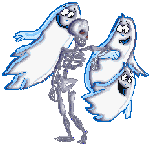 Ball and Pagan Festival |
October 27, 28 and 29 2000
Whether you are Pagan or just Pagan-friendly -- come along and have a great time !! |

|
||
Please Note: By necessity, these definitions are general. Each Pagan in every tradition could define their path differently, so use this as a general guide only. You will find most, if not all, of these definitions on various other Pagan Internet sites. Duplication of this page elsewhere on the Internet is permitted as long as a link to this web site is included. This page is not a duplication of any one particular Internet page but a conglomeration of definitions from various Internet sites, books and other sources.
The 1734 Tradition: British flavored, sometimes eclectic tradition based on the ideas of poet Robert Cochrane, a self-titled hereditary Witch. 1734 is said to be a cryptogram for the name of the Goddess honored in this tradition. Alexandrian Tradition: A popular tradition that began in England around 1960 and was founded by Alex Sanders. It is similar in some ways to the Gardnarian Tradition. Alex Sanders drew much attention from the media and was referred to (by the media) as the "King of Witches". Asatru/Norse Paganism: With its origin in northern Europe, this tradition is practised today by those who feel an affinity with their nordic and teutonic ancestors, and who wish to study the Sagas, Eddas and Runes. Asatru and Norse Paganism encourages a sense of responsibility and spiritual growth, often within the context of noble warrior traditions. British Traditional Witch: A tradition with a strong framework of structure and degrees. The members of the International Red Garters are considered British Traditionalists. Rituals appear to encompass the feel of Celtic and Gardnerian paths. Celtic Paganism: This is native to the Celtic and Gaelic races, and is practised by a great many people in Australia and New Zealand today, who still feel a stong connection to their Celtic-Gaelic roots. The essence and the teachings of the Celtic religion were encoded into the ancient legends, which were transmitted orally by the bards to the people. Modern Celtic Pagans are seeking to re-introduce this wealth of truth and knowledge into our Modern World.
Celtic Wicca: A very earthy tradition, this one focuses on nature, the elements and elementals, sometimes faeries, plants, etc. Many "Green Witches" and "Eclectic Druids" follow this path that looks to the ancient Celtic pantheons for their Gods and Goddess.
Caledonii Tradition: A tradition that attempts to preserve the ancient festivals of the Scottish and is sometimes known as the Hecatine Tradition. Ceremonial Witchcraft: Uses ceremonial magick to attain a stronger connection with divinity and realize their higher purposes and abilities. Rituals are often derrived from Quabbalistic magick (which is flavored by the Judeo-Christian history) and Egyptian magick. Dianic Witchcraft: A tradition which honours and celebrates the feminine aspects of divinity. Women are accorded great respect, and rituals are often designed to empower women with a sense of their own inherent spirituality and value. The name 'Dianic' is taken from the hunter goddess, Diana. Druidry: The modern tradition of Druidry emphasises artistic skills such as poetry and music, and often encourages its members to undertake a study program in these, and other more academic disciplines. Males and females can become Druids.
Eclectic Pagan/Witch: A Pagan/Witch that blends the ideas of many traditions or sources. Like
a Witch's cauldron, ideas are added to season the brew, spice it up, make it more effective, etc. This 'tradition' that isn't really a tradition has the flexibility to endure changes, but sometimes lacks grounding. Generally, rituals are self-styled and covens are loosely structured. Can also be known as a Natural Witch/Pagan.
Environmental Paganism: Many Pagans today do not follow a specific tradition, but actively work to save the Earth from further desecration, and honour the land upon which we live as a sacred representation of the Earth Mother. This style of religion often has no formal rites or method of worship, but encourages each individual to honour divinity by caring for the Earth and all its creatures (animal, plant, mineral, etc.) Ethnic Paganism: Many modern Pagan traditions are based upon practices of a particular ethnic group, some modern, some ancient. In this category would come traditions such as Hellenic, Roman or Egyptian Paganism, as well as modern traditions continued by their ethnic groups; for example, voodoo, Santeria and Native American traditions. This would also include the native Pagans traditions of the Pacific, and Australia's Aboriginial people. Unfortunately a great many myths and traditions, and tribal lore, has been lost as a result of the uncompromising practices of missionaries and settlers. Faery/Faerie/Feri Tradition: There are several 'Faery' traditions. A Faery Witch could be but isn't necessarily working with nature energies and spirits, also known as Faeries, Sprites, etc. A Faery Witch could be but is not necessarily restricted to being a homosexual and/or following one of the Faery, Feri or Faerie Traditions. A couple 'big' names in this arena are Victor and Cora Anderson, Tom Delong (Gwydion Penderwyn) etc.
Gardnerian Tradition: Founded by Gerald Gardner in the 1950's in England. This tradition has contributed greatly to much of the Craft as it is today. The structure of many rituals and magickal workings in numerous traditions originated from Gardner's work. Some of the historical claims made by Gardner himself and by some Gardnerian Witches have yet to be verified (and in some cases have been disproven) however, this structured tradition has backed many modern Witches.
Hecatine Tradition: A Pagan/Witch who seeks inspiration from Hecate and attempts to reconstruct and modernise the ancient rituals of her worship or similar to the Caledonii Tradition Hedge Witch: A Witch who is not affliated with any group or person, usually solitary, who uses folklore, magick and herbalism. Some Hedge Witches believe in a God and Goddess. This type of Witch is usually associated with the images of the village Wisewoman and Cunningman. Hereditary Witch: A Witch that was usually trained by a family member and/or can trace their family history back to another Witch or Witches. Kitchen Witch: A practical Witch who is often eclectic and focuses on magick and spirituality centering around the 'hearth and home'. Pictish Witchcraft: Often, but not always a solitary path that focuses on the divine in nature. Maybe similar to Environmental Paganism.
Male Mysteries: A collection of practices which have become popular with modern male Pagans, seeking to explore their own sacred manhood. Different to partriarchal religions (Christianity, Islam, Judaism), these mysteries are focused towards spiritual growth gained through solitary or small group practice.
Pow-Wow: SilverRavenwolf, the author, has more to say on this path. It is more of a magickal system than a spiritual path and can be incorproated into diverse religions. Pensylvania (USA) was a prime settlement of this 400+ year old German Tradition. Much of what is left of pow-wow magick is 'Water Witching' and 'Faith Healing' but that is changing! Satanic Witch or Church of Satan: The Church of Satan was founded in 1966 by a San Franciscan named Anton Szandor La Vey. It was formed in responce to religious hypocrisy and conservatism. 'Satan' was understood to be a metaphysical presence, independant, assertive and creative. The Satanic religion proposed to raise the individual to personal godhood. Most Satanists follow The Satanic Bible which Anton La Vey wrote. There is debate within the Pagan community at large as to whether to include Satanic Witches under Paganism as Satan is generally conceived as a Christian Diety. Setians or The Temple of Set: The Temple of Set was founded in 1975 by Michael Aquino. Setians reject the desirability of union with the Universe, preferring instead to not to lose consciousness but to continue as individual consciousness after death. Setains think it is possible for the individual consciousness to evolve towards its own divinity through deliberate exercise of the intelligence and will. The Setains view the 'worship' of Set as the 'worship' of individualism and the indulgence of all (legal) desires of the body and ego. Above all, the Setian seeks to honour and enshrine consciousness. Seax-Wicca or Saxon Wicca: Founded in 1973, by the prolific author, Raymond Buckland who was, at that time, a Gardnerian Witch. One of the first traditions to specifically make allowances for solitaries and the self-initiatiation. These two aspects have made it a popular path.
Shamanism: Shamanism utilises skills and practices such as travelling in the spirit realms, tree lore, herb lore, and the use of totem animals. The tribal shaman was often responsible for spiritual matters within the tribe, and also for matters connected with birth, deaht and healing. Shamans are able to speak with the tribal ancestors and gain knowledge for the use of the tribe. These same practices are used in non-tribal societies by many modern Pagan men and women.
Stregharia/Strega/Stregone/Italian Witchcraft: Usually called 'The Old Religion', it is of Southern European heritage. Revived in the 14th Century by the Holy Strega, and passed on as the Legend of Aradia. There are three sub-paths in this Tradition: Janarra (lunar), Tanarra (star) and Fanarra (ley lines). It is said that Aleister Crowley and Gerald Gardner were influenced by the Stregharia. Famous for their Witches Liquor. Traditional Witch: Every traditional Witch will give you a different definition. Often prefers the title Witch over Wiccan and will frequently define the two as very different paths. A traditional Witch bases their work as much as possible on historical methods from their tradition or geographical area of interest.
Make your submission as brief yet detailed as possible.
|
||
 Send us your feedback about H2000 ! Phone: (07) 54963657 Write: PO Box 1190, Woodford, Q, 4514 or Email: festival@4halloween.com or Pagan1@caliph.net.au
If you only go to one festival in the year 2000, go to the best ! Halloween 2000
Halloween 2000 REPORT |
URL: http://h.2000.tripod.com | Image Copyright Information | Site created by SunsetSeashell ( festival@4halloween.com ) | All content © 2000
ADOPT A GHOST



